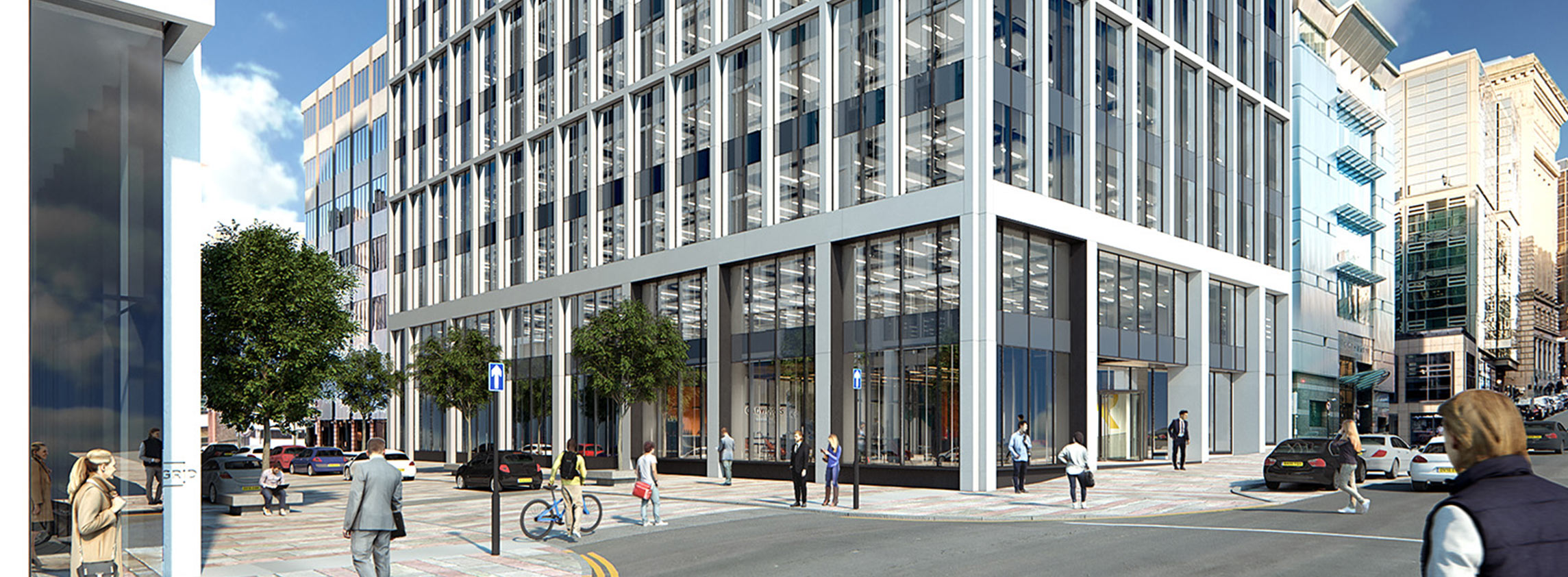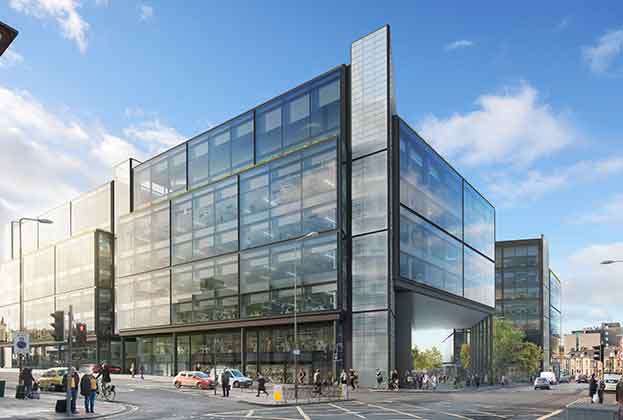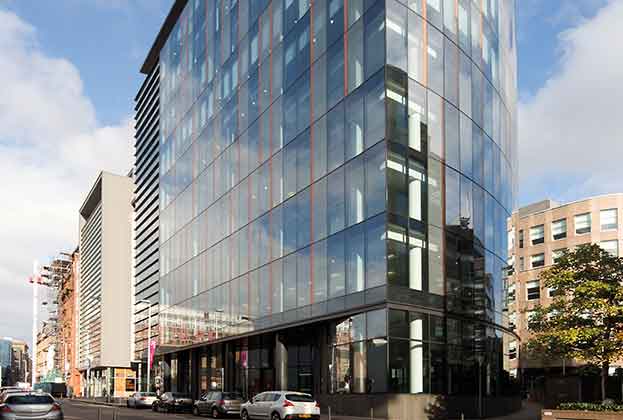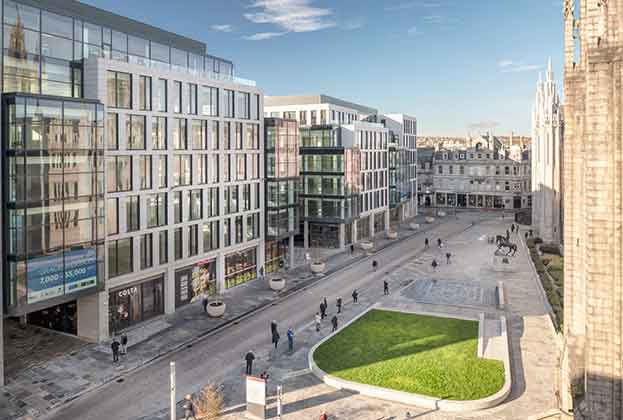As expected, lockdown results in significantly lower levels of H1 take-up but levels of underlying latent demand remain positive
2020 got off to a strong start in Scotland, which saw Q1 core market (Aberdeen whole market, Edinburgh city centre and Glasgow city centre) take-up 87% up on Q1 2019 and 7% above the five-year Q1 average.
However, during the second quarter Covid-19 and the accompanying UK-wide lock-down brought significant disruption to all three core office markets. Q2 saw just 66,521 sq ft of office space signed for across core Scotland reflecting an 85% decrease on the five-year quarterly average. H1 take-up, therefore, totalled 509,212 sq ft, 19% below H1 2019 and 41% below the H1 five-year average.
Although take-up was down from 2019 and the five-year H1 average, a number of key transactions took place. In Glasgow, serviced office provider Orega signed for 14,035 sq ft at 220 St Vincent Street. Handelsbanken signed for 3,581 sq ft of Grade A office space at Edinburgh’s Waverley Gate and Prosafe Offshore Ltd took 6,079 sq ft at Aberdeen’s Grade A Silver Fin building.
Aberdeen was the only market to see increased take-up levels, with total H1 take-up 30% above H1 2019 and 2% above the H1 five-year average. This was largely due to the strength of Q1 in which 171,609, sq ft of office space was signed for. Q2 showed a significant decrease with take-up totalling just 23,472 sq ft reflecting a 75% decrease on the five-year quarterly average.
In Glasgow, H1 totalled 229,182 sq ft reflecting a 10% decrease from the same period in 2019. Q2 was the period that resulted in levels being down, during this time significant disruption caused by the UK-wide Covid-19 lockdown saw Glasgow’s Q2 take-up 85% below the five-year quarterly average. Similarly in Edinburgh, Both H1 and Q2 take-up volumes were significantly below average levels with H1 take-up totalling 84,949 sq ft in which 14,322 sq ft occurred during the second quarter.
19% of deals were for Grade A space, significantly below the annual average proportion of around 50%, highlighting the lack of Grade A space across all markets. Currently, there is just 914,812 sq ft of Grade A office space available in core Scotland reflecting a 9% decrease since the end of 2019. Total supply has reduced by 4% and now sits at 3.8 million sq ft.
19% of deals were for Grade A space, significantly below the annual average proportion of around 50%, highlighting the lack of Grade A space across all markets
Savills Research
The Public Services, Education & Health sector accounted for a significant proportion of take-up (28%) totalling 141,775 sq ft. A key deal to this sector included Visit Scotland, which signed for 3,270 sq ft at 90 St Vincent Street, Glasgow, during the second quarter. The Extraction & Utilities and Technology, Media & Telecoms sectors were also key contributors accounting for 22% and 15% of take-up respectively.
Despite currently reduced levels of take-up, many medium/longer-term property searches are still progressing. Additionally, with a likely increased trend towards accommodation that caters to staff well-being, the pandemic may drive other occupiers to consider relocations in the medium term and favour landlords with better quality accommodation.
Rents above £35.50 per sq ft have now been achieved in Edinburgh city centre, although as many transactions are subject to NDA's full details are not available. Prime rents in Aberdeen and Glasgow are both now £32.50 per sq ft.
Scotland is still in a period of lockdown due to the Covid-19 pandemic. Savills, therefore, expects activity in the Scottish occupational market to increase significantly once this period has come to an end. It should be noted, however, that take-up is a lag indicator and may take some time to reflect renewed levels of activity.
Investment overview
Scotland’s commercial property investment market has been heavily affected by the Covid-19 pandemic. During the first half of the year, Scotland saw total commercial investment volumes of £331 million, reflecting a 73% decrease from the same period last year and a 59% decrease on the H1 10-year average. The retail sectors saw the largest levels of investment, accounting for 39% and totalling £129 million.
Office investment totalled £60 million, an 88% decrease from H1 2019 and 81% below the H1 10-year average. Typically, around 50% of Scotland’s office investment comes from overseas investors. Therefore, the global disruption caused by Covid-19 during H1, has likely had a significant impact on Scotland’s office investment volumes.
Furthermore, the UK-wide lockdown which required most offices in the UK to become temporarily closed, came into effect at the end of Q1. This caused further disruption and almost certainly reduced both domestic and international confidence in Scotland’s office market.
The majority of office investment occurred within Edinburgh (75%), which is likely due to it being the capital. In times of economic uncertainty, investors often favour capital cities as they are typically viewed as a safer option.
Although volumes were significantly down, a number of key transactions took place. Most notably, KanAm purchased 4North, Edinburgh for £30 million, reflecting an impressive 4.3% yield. The building, which underwent a complete refurbishment in 2019, is fully-leased to Computershare.
Other key deals included the sale of 4–5 Lochside Avenue, Edinburgh, for £7 million reflecting a 7% yield and the purchase of Aspect House, Hamilton, for £15 million with a 6.5% yield.
Prime yield in Aberdeen is currently 6.75%, Glasgow 5.25% and Edinburgh 4.75%. The uncertainty caused by the Covid-19 pandemic has seen yields in Aberdeen, Edinburgh and Glasgow shift outward by 25 basis points.
Read the articles within Spotlight: Scotland Offices below.



